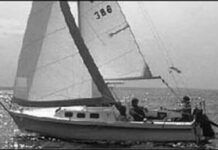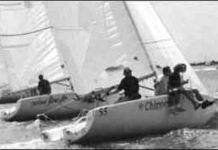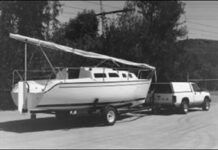C&C 40
The C&C 40 entered production as a 1978 model, and was phased out in 1983, replaced by the higher-performance C&C 41. The 40 has good all-around performance upwind and downwind, in both light and heavy air. Despite a wide maximum beam, the boat's ends are fairly well balanced, and the rudder is deep enough to stay in the water in all but a flat-out broach.
Rob Roy 23
In 1983, the Rob-Roy 23 was the only trailerable canoe-stern yawl in town. Its appeal, however, goes beyond novelty. This is a boat with character: She looks salty; sails well with working sails alone; and she provides accommodations for two. Simplicity, from a space-saving centerboard to a "hardened" kick-up rudder, from an unstayed mizzen mast to a tabernacle-mounted mainmast, is a watchword. The Rob Roy can be launched at a ramp and is easily beached due to its 1' 7" draft with the board up. Owners have cruised her for weeks at a time and routinely cross the Gulf Stream and other formidable chunks of open water.
Jeanneau Sun Odyssey 36.2
Though designed as a performance cruiser, the designers clearly intended the Jeanneau Sun Odyssey 36.2 to be comfortable at anchor. The French Euro-style favors wide scoop transoms, which the marketing agencies highlight through ads showing bikini-clad girls sitting seductively on the steps, shower head in hand. The 36.2 fits this stereotype.
Rhodes 22
Designed by Phillip Rhodes back in 1960, the Rhodes 22 is a trailerable cruiser for a couple that wants the amenities of a larger boat without putting up with the hassles and expenses of a larger boat. It's clearly not a racing boat. It's also not a "shoehorn special," whose claim to fame is how many persons it can sleep. And it's not an inexpensive boat for its size. The Rhodes 22, from its inception, has been a purpose-built boat. And, with a history of detail improvements and some innovative thinking, it meets that purpose quite well.
Express 37
The concept for the Express 37 was developed in 1984 by Schumacher and boatbuilder Terry Alsberg of Alsberg Brothers Boatworks in Santa Cruz. Schumacher's objective was to design a boat that would excel on long ocean races that emphasize performance on reaching and running legs, that would meet the TransPac Race minimum size entry requirements, and also would have at least 6' of standing headroom.
PDQ 32
The PDQ 32 was introduced in 1996. The concept was to offer a smaller, lighter and less expensive alternative to the PDQ 36. One of the things we like about PDQ boats is the quality materials and generally clean workmanship. A modified epoxy resin (AME 5000) and tri-axial knitted fiberglass fabrics are used in the hull and deck. The mast is supported in part by a carbon fiber-reinforced deck beam. The hulls are solid glass below the waterline and cored with Klegecell foam above the water, an arrangement we think makes a lot of sense. Each hull has an air-tight comparatment forward, which provides a measure of safety in the event of collision, and the keels also have sacrificial sections. When you poke around in lockers, you don't see a lot of unfinished glass.
Caliber 33
The Caliber is a peculiar blend of tradition and innovation, of security and performance, of practicality and pizzazz. All of the owners we heard from were "satisfied." One called the 33 his favorite boat over six decades of sailing.
Melges 24
Introduced as a prototype at Key West Race Week barely three years ago, the Melges 24 has already created the same sensation in the small boat performance world as the J/24 when it was first introduced. We're not suggesting that we should commence composing the epitaph for the J/boat, especially since hull number 5,500 was launched recently and sales are still strong, but we are preparing ourselves for a high noon, main street shoot-out between the aging sharpshooter and the young gun as they wrangle for ownership of the small-boat race market.
Catalina 27
The Catalina 27 has been in production since 1971, and well over 6,000 of them have been built. This is undoubtedly the largest production run of any 27' sailboat in US history, and probably the biggest anywhere. The flip side of the coin is that Catalinas are known as cheaply built boats, with lots of corners cut in places they shouldn't be cut.
Santana 2023
With the introduction of the Santana 2023, one of the newer water-ballasted trailerables, the W.D. Schock Corp. in Southern California offered entry-level sailors the same types of mix-and-match options available at an automobile showroom. The A model is your basic family sloop with a contemporary, low-profile cabin. The 2023 C (cruise) has a longer trunk cabin with more amenities below. The 2023 R (race) is optimized for performance with a sprit for flying asymmetrical spinnakers, though you can add a tall mast to either the A or C model. The R model has the same cabin top as the A model, which we think is more attractive, but has less headroom below, of course.















































